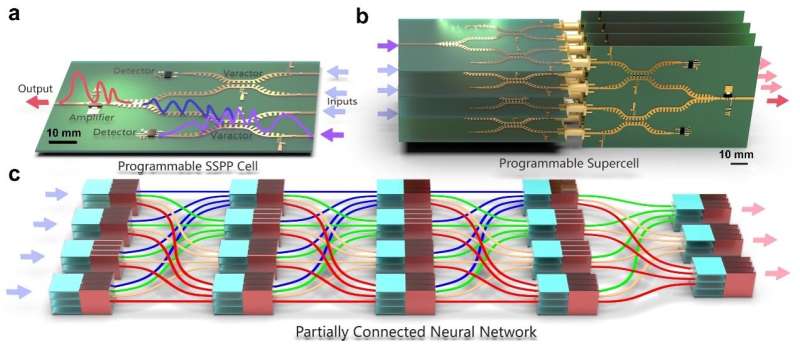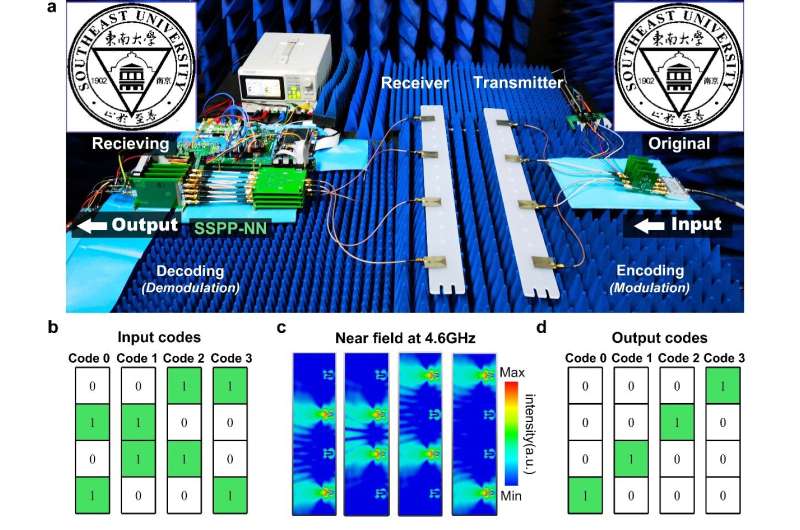May 17, 2023 feature
This article has been reviewed according to Science X's editorial process and policies. Editors have highlighted the following attributes while ensuring the content's credibility:
fact-checked
peer-reviewed publication
trusted source
proofread
A programmable surface plasmonic neural network to detect and process microwaves

AI tools based on artificial neural networks (ANNs) are being introduced in a growing number of settings, helping humans to tackle many problems faster and more efficiently. While most of these algorithms run on conventional digital devices and computers, electronic engineers have been exploring the potential of running them on alternative platforms, such as diffractive optical devices.
A research team led by Prof. Tie Jun Cui at Southeast University in China has recently developed a new programmable neural network based on a so-called spoof surface plasmon polariton (SSPP), which is a surface electromagnetic wave that propagates along planar interfaces. This newly proposed surface plasmonic neural network (SPNN) architecture, introduced in a paper in Nature Electronics, can detect and process microwaves, which could be useful for wireless communication and other technological applications.
"In digital hardware research for the implementation of artificial neural networks, optical neural networks and diffractive deep neural networks recently emerged as promising solutions," Qian Ma, one of the researchers who carried out the study, told Tech Xplore. "Previous research focusing on optical neural networks showed that simultaneous high-level programmability and nonlinear computing can be difficult to achieve. Therefore, these ONN devices usually have been limited to specific tasks without programmability, or only applied for simple recognition tasks (i.e., linear problems)."
The primary objective of these researchers' recent work was to further improve the performance of neural networks on complex nonlinear problems, while also making them suitable for a broad variety of applications. SPNN, their proposed architecture, can be programmed for different weight configurations, which means that it should theoretically generalize well across different tasks.
The research team led by Prof. Cui has been developing programmable spoof surface plasmonic devices and exploring their use for electromagnetic regulations for several years. Inspired by their previous findings, they thus set out to develop a neural network with programmable weights and activation functions based on one of these plasmonic devices. In principle, the architecture they proposed could achieve remarkable processing speeds, approaching the speed of light.
"The SPNN was created in a layer-by-layer fashion, where each layer consists of multiple programmable SSPP supercells," Ma explained. "Each supercell with a four-in and four-out fully connected network is composed of eight programmable SSPP cells. We design a three-dimensional composite structure, which cleverly realizes the characteristics of the full connection."

Each of the programmable supercells that the researchers used to create their platform is made up of a SSPP power divider and a coupler. This unique design allows it to robustly manipulate electromagnetic waves and then use them to realize plasmonic neural networks.
"The weight parameters of neural networks are adjusted by changing the voltages of varactors loading on the couplers," Ma said. "More importantly, the activation function can be customized by detecting the input intensity using detectors and feeding back the threshold to an amplifier. The SPNN can perform an image classification task and can also be used to create a wireless communication system to decode and recover images."
The most notable features of the team's SPNN architecture are its programmable weights and activation functions, which could make it easier to apply to a broad range of tasks. Some previous works realized programmable neural networks using phase change materials, yet this approach was found to result in limited dynamic ranges.
"Although diffractive deep neural networks can flexibly modulate and process electromagnetic waves, their lack of nonlinear activation functions also limits their potential to handle more complex problems such as the exclusive-or (XOR) logic operations," Ma said.
"Our proposed programmable SPNN based on digital surface plasmonic devices may bring some new ideas into this field. Programmable SSPP devices can control electromagnetic waves with simple architecture, low cost, and high efficiency, which is a potential for building programmable neural networks. Moreover, we can use a closed-loop feedback system between detection ports and amplifier bias circuits to realize programmable activation functions."
In the future, the SPNN developed by this team of researchers could be used to detect and process microwaves on a large scale, thus potentially opening new possibilities for 5G and 6G wireless communications. In contrast with some of the ANN-based solutions for microwave detection introduced in the past, SPNN can directly modulate electromagnetic waves at speeds that approach the speed of light.
In their paper, Prof. Cui, Ma and their colleagues showed that the same architecture also performs well on other tasks, for instance classifying handwritten digits with high levels of accuracy. In their next works, they plan to evaluate SPNN on other tasks, while also increasing its complexity so that it can tackle more advanced problems.
"The prototype implemented in this work is based on a 4×4 fully neural network, which is relatively low," Ma added. "The SPNN structure resembles a circuit system, which means that the scale of SPNN layers could be enlarged without increasing the footprint of the device. For example, a cubic structural form could be created to reduce the physical size of the partially connected system, achieving ultra-high spatial utility in three-dimensional space. Additionally, we can also reduce the size of the network by improving the operating frequency band."
More information: Xinxin Gao et al, Programmable surface plasmonic neural networks for microwave detection and processing, Nature Electronics (2023). DOI: 10.1038/s41928-023-00951-x
© 2023 Science X Network


















